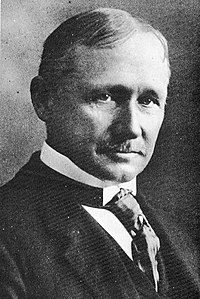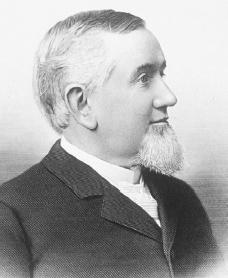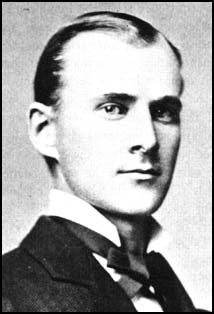I) I. The Expansion of the AFL
A. Wilson Administration--Woodrow Wilson's administration courted the support of labor, particularly in his campaign for a second term. This is perhaps best illustrated by the fact that Wilson became the first sitting president to address a convention of the AFL
1. Creation of the Department of Labor--in 1913, Woodrow Wilson created the cabinet-level position of Secretary of Labor, and appointed former United Mine Workers union official William B. Wilson (no relation) as the first secretary.
2. Clayton Act--although it fell far short of being "labor's Magna Carta" that it was proclaimed by Samuel Gompers, the Clayton Act was intended to limit the power of the courts to use the Sherman Anti-Trust Act against labor strikes, since the legislation exempted labor unions from prosecution under the anti-trust law.
2. Commission on Industrial Relations (1915)--reported that much of the labor unrest of the previous two decades was due to the refusal of management to bargain collectively with unions.
4. Adamson Act (1916)--gave railroad workers the right to bargain collectively, as well as setting the eight hour day as the standard work day, with overtime pay guaranteed for any time worked over that eight hours.
B. Wartime Labor Conditions
1. End of European Immigration--the outbreak of hostilities in Europe largely ended immigration from the continent to the United States, since immigrants were now needed by their homelands for manufacturing war goods and cannon fodder. The danger of transatlantic travel during wartime also deterred immigration.
2. Economic Expansion--although the outbreak of war in Europe initially caused a brief recession in the United States, by 1915 the demand for war goods from Europe was largely responsible for an economic boom, because US companies were relied upon to provide these goods.
1.US job market--the lack of European immigrants meant that companies could no longer use the immigrants transitory status--and willingness to work for less--to keep wages depressed. Employers also had to increase their recruitment efforts within the United States.
2. Internal Migration--the economic expansion encouraged a great number of Americans to move from their rural homes--North and especially South--to industrial urban centers in the North
II. Industrial Democracy
A. Wilson Administration--Woodrow Wilson's administration courted the support of labor, particularly in his campaign for a second term. This is perhaps best illustrated by the fact that Wilson became the first sitting president to address a convention of the AFL
1. Creation of the Department of Labor--in 1913, Woodrow Wilson created the cabinet-level position of Secretary of Labor, and appointed former United Mine Workers union official William B. Wilson (no relation) as the first secretary.
2. Clayton Act--although it fell far short of being "labor's Magna Carta" that it was proclaimed by Samuel Gompers, the Clayton Act was intended to limit the power of the courts to use the Sherman Anti-Trust Act against labor strikes, since the legislation exempted labor unions from prosecution under the anti-trust law.
2. Commission on Industrial Relations (1915)--reported that much of the labor unrest of the previous two decades was due to the refusal of management to bargain collectively with unions.
4. Adamson Act (1916)--gave railroad workers the right to bargain collectively, as well as setting the eight hour day as the standard work day, with overtime pay guaranteed for any time worked over that eight hours.
B. Wartime Labor Conditions
1. End of European Immigration--the outbreak of hostilities in Europe largely ended immigration from the continent to the United States, since immigrants were now needed by their homelands for manufacturing war goods and cannon fodder. The danger of transatlantic travel during wartime also deterred immigration.
2. Economic Expansion--although the outbreak of war in Europe initially caused a brief recession in the United States, by 1915 the demand for war goods from Europe was largely responsible for an economic boom, because US companies were relied upon to provide these goods.
1.US job market--the lack of European immigrants meant that companies could no longer use the immigrants transitory status--and willingness to work for less--to keep wages depressed. Employers also had to increase their recruitment efforts within the United States.
2. Internal Migration--the economic expansion encouraged a great number of Americans to move from their rural homes--North and especially South--to industrial urban centers in the North
II. Industrial Democracy
A) Definition – actually, there is no one definition of industrial democracy—it meant different things to different people. To workers, it meant that they would have a say in how a factory or other kind of business would be run. To owners of the factories and businesses, it meant that for the duration of the war they would tolerate government interference in the running of their business, in return for guaranteed profits—but only to the end of the war.
B) A. Different views of Industrial Democracy
1) 1. Americanization programs – largely under the control of the capitalist class, intended to make workers think and act like “Americans.”
(a) a. Banishment of German language newspapers – distribution of German language material through the mail was banished in 1917, which effectively ended the large German press in the United States.
(b) 2. Company-sponsored programs
(i) a. Ford Motor Company – in the period just before the war, Ford introduced his famous “Five Dollars a Day” program, which he proposed to pay workers in his factories five dollars a day (about twice the then going rate for factory workers). To qualify, workers had to pass inspection from the Ford Social Department, who ensured that workers were living frugally and would not dissipate the salary that they were to receive. Immigrant workers, in addition to this, were also required to attend language classes if they did not speak English, and were lectured on work habits, personal hygiene, and table manners; they were also encouraged to move out of ethnic neighborhoods, and not to take in borders.
(c) b. Loyalty organizations – groups like the American Protective League were formed by natives born to enforce their vision of Americanization upon the foreign born, as well as other natives who did not fit their vision of proper conduct.
(d) Restrictions on immigration – although the numbers of immigrants was not restricted by law until 1924, and the effect of that law did not come into effect until 1929 (when, due to the world-wide depression, immigration would have fallen off, anyway), restrictions were placed upon immigration before that time period.
(i) Literacy test – immigrants had to prove that they could read and write in their native language—a law the AFL staunchly supported. The law was passed by Congress over President Wilson’s veto
2) B. Industrial democracy for working people.
(a) 1. Labor as a partner in society – the symbolic importance of the positions that AFL president Samuel Gompers held should not be discounted in importance; this gave the working people that he represented (the single largest group, and growing during this time period) the impression that they finally had some influence in government.
(b) 2. Success of labor actions – with sympathetic members sitting on the War Labor Board, which was charged with adjudicating labor disputes, labor unions increasingly won recognition from companies, and modest wage increases for the workers they represented (which companies could afford to grant because many of them operated with “cost-plus” contracts from the Federal Government—which meant that the companies were guaranteed a certain level of profit).
II) a. Reaction to Industrial Democracy – after the signing of the Armistice, companies in the United States moved to rescind many of the agreements that had been reached during the war years.
A) 3. 1919 Strike wave
1) a. Seattle General Strike – a strike instigated by the International Associations of Machinists, who represented shipbuilding workers in the city. Eventually, most workers in the city joined the machinists on strike, and a workers’ strike committee ended up running the city for three days—providing law enforcement, food distribution, and other essential services.
2) b. Rossford Ford Plate Glass strike – led by the IWW, began the same time as the Willys-Overland strike; strike leaders were swiftly arrested, and carted off to Wood County county seat Bowling Green (with the assistance of a number of volunteer deputies recruited from the normal college there), where they were held largely incommunicado. Catholic school children were told that there parents would be excommunicated from church if they attended a strike rally in Toledo; management in the factory armed and deputized by county; after several weeks, with the assistance of strikebreakers, strike defeated.
3) c. Willys-Overland strike – Willys attempted to unilaterally impose a wage cut on workers; offered a profit-sharing scheme to workers, which was rejected. When wage cut imposed anyway (in the form of a longer work day with no increase in wage), many workers walk off job at normal quitting time; workers are fired, and strike called. Workers from Lagrange Street area board west-bound streetcars on Central, all workers who cannot produce a Chevrolet work badge are made to get off the streetcar. Strikebreakers are hired, and housed within the company compound; strikers surround compound. Sweeping injunction granted after North Carolina auto dealer claims business adversely effected.
4) d. Steel strike – AFL made concerted attempt to organize steel workers during the war, and this attempt continued during period just after the war. Most success occurred in the area around Chicago, and result encouraged attempts to organize workers in the Pittsburgh area. Leadership of this drive was given to former Wobbly William Z. Foster, who had headed up a similar drive on the behalf of the Chicago Federation of Labor and the Amalgamated Meat Cutters and Butchers to organize packinghouse workers in Chicago area. Steel companies refused to negotiate; used Foster’s syndicalist past to discredit him, and eventually crush the strike.
5) e. Boston Police Strike – walkout of the Boston Police force led to several nights of general lawlessness, although property damage was fairly minimal. The governor of Massachusetts, Calvin Coolidge ordered the firing of the entire police force, and mobilized the state militia to police the city. This strike, perhaps more than any of the other of the hundreds that occurred, scared those in power most.
B) 4. Reaction of governing elite
1) a. Red Scare – led by US Attorney General (and Presidential wannabee) A. Mitchell Palmer, a nationwide coordinated attack against known and suspected radicals took place in early January 1920, when hundreds were arrested, with a suspension of the rights of habeous corpus; some of those arrested are deported on minor violations; some of those who were American citizens—like Big Bill Haywood—jumped bail and left the country (Haywood fled to the Soviet Union, and is buried in the wall of the Kremlin).
2) b. Institution of the “American Plan” – this plan was part carrot, and part stick. While unions were unwanted in the workplace, in many factories the indiscriminate powers of the foreman were curtailed, and powers to hire and fire were given instead to newly instituted personnel departments.
(a) c. Power of foremen curtailed
(b) Institution of personnel departments
(c) Grievance procedures
(d) Profit-sharing and stock options plans
(e) No collective bargaining, however
1) Fordism – Ford’s contribution to the automotive industry was his drive to reduce the cost of the automobile, so that it would become more widely accessible to the general public; Ford accomplished this by increasing the number of specialized machines used to create parts for the automobile. This had two advantages: it decreased his reliance upon skilled workers, who could demand higher wages; and it allowed him to set a specific pace of manufacturing, rather than letting the workers set their own pace
(a) Model T – extremely limited choice (it came with no options, and in one color—black), but this allowed Ford to perfect its manufacture—which in turn allowed Ford to drop the price of the automobile from $950 when it was introduced in 1909 to $290 at the height of its popularity in 1924
(b) $5 a Day – the famous $5/day wage, instituted in 1914, was approached by few workers, but it helped limit the turnover of 300%; the higher overall wage also allowed workers to purchase the product that they were manufacturing (analogy to Bush directives for Americans to do their “patriotic duty” and purchase stuff in reaction to Sept. 11)
(c) Increased mobility – ownership of an automobile allowed many more people to move to the suburbs (or “into the country’); also created a greater demand for recreation—along with more workers employed in routinized labor.
2) Sloanism – named after the President of the General Motors Corporation, Alfred P. Sloan. Sloanism is in many ways the perfection of Fordism; automobiles were provided in a variety of styles (kind of), and a variety of price ranges
(a) Creation of the General Motors Acceptance Corporation – GMAC created in order to provide financing for potential automobile purchasers who could not pay cash for an automobile.
(b) Triumph of Sloanism – by 1927, falling sales of the Model T forces Ford to shut down production, and re-tool for the production of the Model A. In 1924, Ford had commanded 55% of the new car market.
(c) Increased importance of advertising – used to help people differentiate between largely undifferentiated products; advertising allowed companies to manufacture desires in their customers.
III. The Strikes of the 1920s
A. Coal Mining
1. Battle of Matewan
2. Battle of Blair Mountain--after the events at Matewan, the UMW called on miners and other union members to assemble in West Virginia, armed, to ensure the safety of union miners in the state. Some 10,000 to 15,00 men answered the call, and marched south to Mingo County, where they took part in the largest armed insurrection in the United States since the Civil War.
B. Railroad Industry
1. 1922 Railroad Shopmen's Strike--when the Rail Board approved a 7 cent an hour wage reduction, shopmen voted to go out on strike. The railroads were able to hire enough strikebreakers to fill about three-fourths of the positions; this provoked a violent response from strikers, who attempted to intimidate strikebreakers to stop them from taking their jobs; this in turn brought forth the full police force of the government.
C. Textile Industry
1. 1929 Gastonia Strike--although textile manufacturers had moved South to avoid labor confrontations, working conditions in the mills provoked workers in Gastonia, North Carolina, to attempt to unionize in 1929. Led by members of the Communist Party, the strike provoked violence from both mill owners and local government. After the headquarters of the National Textile Workers Union (NTWU) in Gastonia was attacked, and striking workers evicted from their company-owned homes, a tent city was erected on the outskirts of town, guarded by armed strikers. When the sheriff showed up to demand the strikers turn over their guns, an altercation occurred and the sheriff and several miners were killed. Eight miners were charged with murder, and convicted on rather flimsy evidence--thus breaking the strike.
III. The Strikes of the 1920s
A. Coal Mining
1. Battle of Matewan
2. Battle of Blair Mountain--after the events at Matewan, the UMW called on miners and other union members to assemble in West Virginia, armed, to ensure the safety of union miners in the state. Some 10,000 to 15,00 men answered the call, and marched south to Mingo County, where they took part in the largest armed insurrection in the United States since the Civil War.
B. Railroad Industry
1. 1922 Railroad Shopmen's Strike--when the Rail Board approved a 7 cent an hour wage reduction, shopmen voted to go out on strike. The railroads were able to hire enough strikebreakers to fill about three-fourths of the positions; this provoked a violent response from strikers, who attempted to intimidate strikebreakers to stop them from taking their jobs; this in turn brought forth the full police force of the government.
C. Textile Industry
1. 1929 Gastonia Strike--although textile manufacturers had moved South to avoid labor confrontations, working conditions in the mills provoked workers in Gastonia, North Carolina, to attempt to unionize in 1929. Led by members of the Communist Party, the strike provoked violence from both mill owners and local government. After the headquarters of the National Textile Workers Union (NTWU) in Gastonia was attacked, and striking workers evicted from their company-owned homes, a tent city was erected on the outskirts of town, guarded by armed strikers. When the sheriff showed up to demand the strikers turn over their guns, an altercation occurred and the sheriff and several miners were killed. Eight miners were charged with murder, and convicted on rather flimsy evidence--thus breaking the strike.


















































